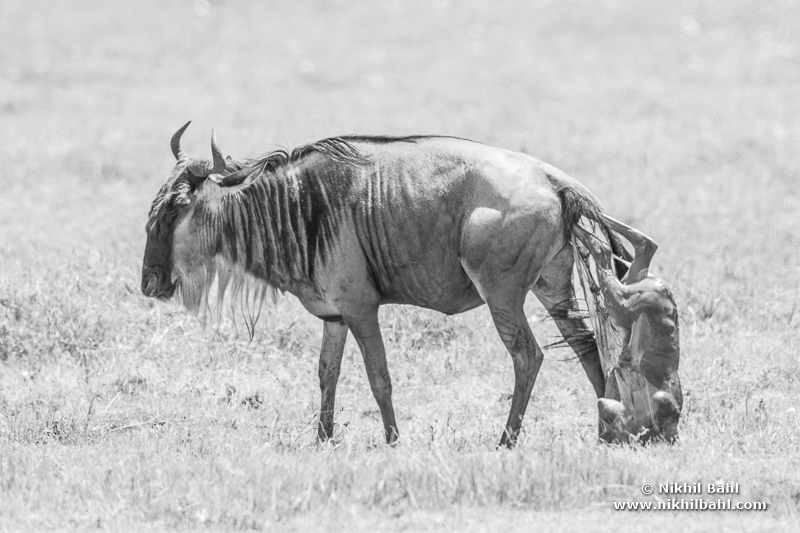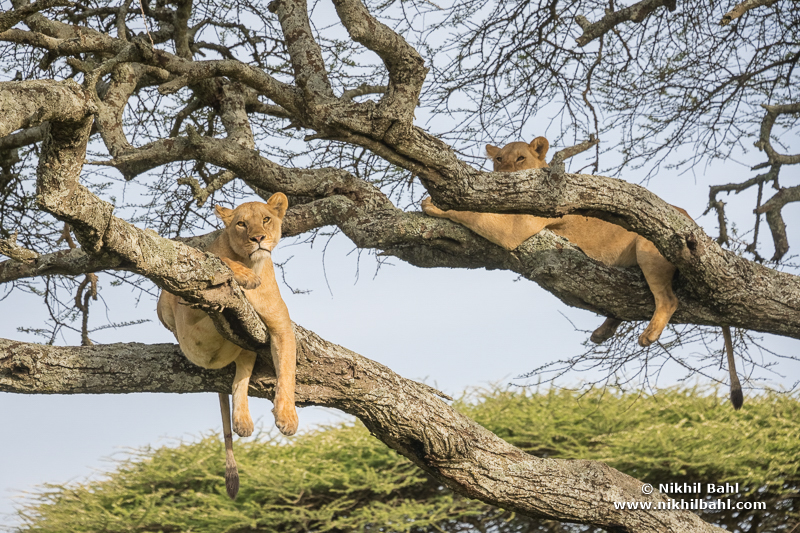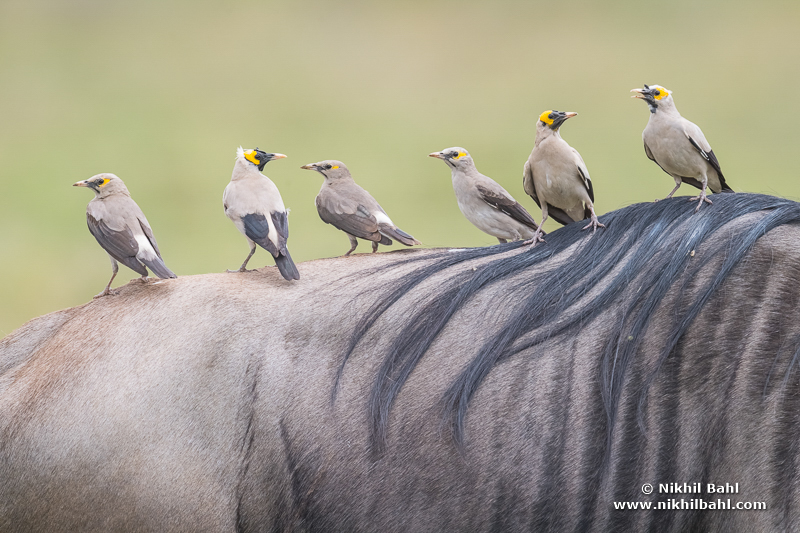Tanzania Photo Safari: Wildebeest Birthing Season
Dates: February 23 - March 8, 2025
Fee: $9,895 (includes lodging and ground transportation)
Deposit: $1,500 (balance due by August 2024)
Limit: 8-9 participants (spouses or non-photographers are welcome)
Nikhil will work with knowledgeable local driver/guides to make sure you have a great experience. Every vehicle will have no more than 3 photographers and each photographer will have their own row of seating.
View Photos from location >>>
|

A photo safari in East Africa is often considered an experience of a lifetime! We will visit Tanzania's most iconic locations: the Serengeti, the Ngoro Ngoro Crater and Ndutu (part of the Ngoro Ngoro Conservation area). We will also visit Tarangire National Park, which is considered to be one of the best locations in Tanzania to see Elephants. This itinerary has been designed to cover the very best photographic locations that Tanzania has to offer in February. The Wildebeest migrate throughout the year moving through Tanzania into Kenya and back. In February, close to 2 million wildebeest make their way to the Southern Serengeti and northern parts of the Ngoro Ngoro Conservation area, where over 300,000 wildebeest are born in the span of a month. This is a time where there is plenty of food for the predators. We expect to see the big 5 and hope to see the big cats in action. This is also a good time to view young cats as the predators time their litters with Wildebeest birthing season.
Our own private 4x4 land cruisers will be used for game drives and traveling to the different locations. Three photographers per vehicle will allow for maximum flexibility for photography in different directions. Each photographer will have a full row to themselves, which will allow them to comfortably sit in one seat and keep their camera gear handy next to them. This will also maximize comfort during game drives and moving from one location to the next. A set of experienced driver guides has been arranged.

Location details:
Ngorongoro Crater
The main feature of the Ngorongoro Conservation Authority is the Ngorongoro Crater, the world's largest inactive, intact and unfilled volcanic caldera. The crater, which formed when a large volcano exploded and collapsed on itself two to three million years ago, is 610 meters (2,000 feet) deep and its floor covers 260 square kilometers (100 square miles). Estimates of the height of the original volcano range from 4,500 to 5,800 meters (14,800 to 19,000 feet) high. The elevation of the crater floor is 1,800 meters (5,900 feet) above sea level. The Crater was voted by Seven Natural Wonders as one of the Seven Natural Wonders of Africa in Arusha, Tanzania in February 2013. Approximately 25,000 large animals, mostly ungulates, live in the crater. Large animals include Elephant, Buffalo, Eland, Cheetah, Lion, and larger antelopes. Black Rhino are still reported in the park but not so often. Serval cats and Jackals and Hyenas are also there.
Ndutu - Ngorongoro Conservation area
The Ndutu Region forms part of the northern section of Ngorongoro Conservation Area and stretches to the unfenced southern reaches of the Serengeti National Park, a meeting point between these two incredible wilderness areas.
Over two million migratory animals made up of several species wildebeest, zebra, eland and Thompson gazelle move clockwise from Ngorongoro and the Southern Serengeti to the Northern Serengeti into Kenya and back.
This migration route happens because they follow the rains and therefore the new grasses, which grow up rapidly. The Ndutu area is famed for its short grass plains, which grow grass that is particularly rich in nutrients and sustains the migratory animals whilst they have their babies. Traditionally the wildebeest and zebra tend to calve on these plains with a peak around February, which makes for a beautiful natural spectacle and some exciting predator hunting behaviors.
Serengeti
The Serengeti ecosystem is a geographical region in Africa. It is located mainly in northern Tanzania and extends into southwestern Kenya between 1 and 3 degrees south (latitudes) and between 34 and 36 degrees east (longitudes). It spans approximately 30,000 km2 (12,000 sq mi). The Kenyan part of the Serengeti is known as Maasai Mara. The Serengeti hosts the largest terrestrial mammal migration in the world, which helps secure it as one of the Seven Natural Wonders of Africa, one of the ten natural travel wonders of the world. The Serengeti is also renowned for its large lion population and is one of the best places to observe prides in their natural environment. The region contains the Serengeti National Park in Tanzania and several game reserves. The Serengeti is also home to a diversity of grazers, including African buffalo, warthogs, Grant's gazelle, eland, waterbuck, and topi. The Serengeti can support this remarkable variety of grazers only because each species, even those that are closely related, has a different diet. For example, wildebeests prefer to consume shorter grasses, while zebras prefer taller ones. Similarly, dik-diks eat the lowest leaves of a tree, impalas eat the leaves that are higher up, and giraffes eat leaves that are even higher.

Itinerary
The itinerary below is primarily to give you and idea of the logistics and transfer days/times. For location info and details of possible photographic opportunities, please read the section above.
Please note: when logistically possible, we do take breaks in the afternoon. Since it is very hot around (85 degrees F) in the afternoon hours wildlife activity tends to slow down. We take advantage of this time and take a break to rejuvenate as well. However, we reserve the right to change plans to stay out longer or go out earlier to take advantage of any good sighting or activity.
Day 1 (February 23) - Kilimanjaro international airport to Arusha
After landing at Kilimanjaro international in the evening, you will be picked up and transferred to Arusha where we will stay overnight.
Day 2 (February 24) - Arusha National Park
We get a chance to recover from our long journey to Africa. After lunch we head to Arusha National park for an long afternoon game drive. We return to the hotel for dinner. over night in Arusha.
Day 3 (February 25) - Tarangire National Park
After breakfast, we transfer to Tarangire National Park. Our main goal will be to find the herds of Elephants that are abundant in the park. We will hope to spend plenty of time watching their interactions and maybe catch a glimpse of them bathing in the river. Overnight in Tarangire National Park.
Day 4 (February 26) - Tarangire National Park and Masai village
After our morning game drive in Tarangire National Park, we will head to our special lodge near the Ngorongoro Crater, stopping at a Masai village along the way to take in some local culture and tradition. Overnight at lodge near crater.
Day 5 (February 27) - Lake Manyara to Ngorongoro Crater
For our morning game drive we head to Lake Manyara, returning for lunch. In the afternoon, we transfer to our lodge close to the rim of the crater.
Day 6-7 (February 28- March 1) - Ngorongoro Crater
On both days we will have all day game drives in the crater. We will take a picnic lunch with us and return for dinner.
Day 8-10 (March 2-4) - Ndutu
We head to Ndutu and spend 3 nights at this location. Expect to see large herds of wildebeest. We will keep an eye out for borns and if we are lucky, we may get to see a wildebeest give birth in front of us.
Day 11 (March 5) - Ndutu to Serengeti
After a morning game drive, we will leave our lodge in Ndutu and head to the Serengeti. We will carry a picnic lunch with us so can enjoy the wonderful sights of the Serengeti as soon as we enter the park. We will take out time, photographing along the way and make our way to the camp by sunset. We have chosen a remote tented camp in the Serengeti that will be home base for 2 nights. The camps location should put us close to wildlife.
Day 12 (March 6) - Serengeti
We will enjoy the morning sunrise and hope to photograph big cats along with hippos. We will also come across several species of birds as well. If we are lucky we will have the opportunity to photograph the elusive Leopard. We will return to camp for lunch and an afternoon break. By 4pm we will be out for our afternoon game drive and looking for photogenic wildlife.
Day 13 (March 7) - Return to Arusha
After and early breakfast, we start our gamedrive enroute to Seronera airstrip for our scheduled flight back to Arusha. On arrival in Arusha we will be transfered to our hotel.
Our last sunrise game drive in the Serengeti will be followed by a transfer to the airstrip for our charter flight back to Arusha. On arrival we will have time for lunch and shopping. We will have access to a day room where were can freshen up and repack if needed, before our road transfer to Kilimanjaro International Airport.
Day 14 (March 8) - Transfer to Airport for our international flight
Depending on our lfight time we will have breakfast and then be transfere to Kilimanjaro International Airport.
Itinerary Includes:
- All lodging (based on double occupancy; single supplement is $850*)
- Ground transportation and air transfer from Serengeti to Arusha
- Services of experienced guides and drivers
- Water during game drives
- All meals at the lodges/camps
- All necessary permits and park fees
- All in the field instruction
- Comprehensive and detailed information packet including logistics details, packing and equipment lists, and more
|
Itinerary Does Not Include:
- Airfare to Tanzania
- Visa
- Travel insurance (insuremytrip.com)
- Extra activities not specified in the itinerary
- Any drinks with meals
- Tips for guides/drivers and hotel staff
- Incidentals
|
*Single supplement may be required if we cannot pair you with a roommate; we will inform you of the rooming arrangements as the trip fills.
|
A $1,500 deposit is required for registration. The balance amount should be paid by check. This is done to keep the fees down and pass on the benefit to you.
|
Please contact Nikhil if you have any questions.
Back to Workshop page |